Review: Cadillac CTS-V Coupe, Take Two

If Lord Acton were alive today, I’m sure he’d say: “Power tends to corrupt, absolute power corrupts absolutely. Great cars are almost always bad cars.” I believe it this philosophy that Cadillac hopes will rejuvenate Cadillac, a brand that only recently started taking performance seriously but is already achieving some surprising results. Already our own Michael Karesh has got his kicks with the CTS-V wagon, Niedermeyer has drooled over the sedan and Jack Baruth has killed the track at Monticello in both this coupe and the sedan… it might be safe to say Caddy has a winner on their hands. Still, why not snag the 556 HP V Coupe for a week to see how it handles some California road testing? What’s the worst that could happen?
In 1999 General Motors set the tone for Cadillac’s renaissance with the Evoq show car. Somehow finally realizing that there was frankly no way a Catera, Seville or Deville could ever compete with BMW or Mercedes on any level what-so-ever, the CTS-V, STS-V and XLR-V erupted out of some hitherto unknown Detroit volcano. The first trio of unique Cadillac products were angular and brash at a time where oval was the shape du jour. Sadly the STS-V never achieved the sales success Cadillac dreamt and while I loved the Corvette-based XLR, it had a tiny flaw: a six-figure price tag and the heart of an anemic squirrel (compared to its C6 Corvette cousin). Consequently, the XLR sold like ice to an Eskimo. Packing a (comparatively) demure 443HP Cadillac Northstar V8 into the Corvette chassis, the XLR-V started in the nosebleed section at $101,300 (2008 model year.) For the CTS-V, Cadillac perhaps rightly corrected the performance formula by jamming a thoroughly corrupt 556hp Corvette-derived engine into bespoke Cadillac coupé chassis starting at a lowly $63,465. This is not your father’s Cadillac nor is it available in Mary Kay pink.
Some observers may find Cadillac’s all-angular look distasteful, but I rather love it, especially in this, the ultimate expression of the edgy “Art & Science” ethos, with its ginormous triangular rump finished off with coffee-can sized twin center pipes. Bling-baby-bling. I think a Cadillac should be bold, and since this is the re-invention of the brand (and frankly Cadillac is unlikely to ever again play in the ultra-luxury playground with Rolls and Bentley) styling should set the American wares apart from the masses. Cadillac’s designers are apparently of my same mindset and styled the CTS coupe into something beyond bold: brash. And guess what? It works. I wouldn’t even mind if the CTS got even crazier in the next refresh. Whatever you think of the CTS-V coupe, it doesn’t look like anything else, and that’s a good thing. In every cloud there’s some moisture waiting to rain on your parade however: while the design is avant-garde, the fit and finish is merely pedestrian. Can’t have everything I’m told.
As Michael pointed out in his review of the CTS wagon, the interior of the V is nice, but it’s not as upscale as some of the competition, and since our Coupé tester rang in at over 70-large (twice the price of the base CTS sedan) it’s a bit of a stretch. This is not a problem unique to Caddy however. Any manufacturer that pimps out a base model to this extent suffers from main-stream interiors tied to a premium price tag. For V-duty, Cadillac kept the base CTS’ stitched dash and doors, but continued to eschew the cowhide in favor of pleather on the aforementioned panels which is a shame when most brands dish-up more moo in their performance models.
The slightly more comfortable $3,400 Recaro seats with Alcantara inserts, $300 Alcantara wrapped steering wheel and shifter and $600 dark stained wood accents our tester came with are all optional on the V, so base buyers will find an interior largely the same as the base CTS coupe except for the shiny black center console unique to all V models. Sadly the glossy trim scratches easily and doesn’t, in my opinion, really look quite as good as the silver in the plebian model. Speaking of Alcantara, use of the faux-suede on the wheel looks and feels fantastic but in terms of durability I have my doubts. Alcantara pills as it wears on some surfaces which is a shame because the fuzzy steering wheel almost took my mind off the fact that the Nissan Quest minivan I had the week before had better sport grips. All Vs come standard with the $1,300 gas guzzler tax, a dubious piece of standard equipment to be sure.
As Michael pointed out in his CTS-V wagon review, other flavors of CTS suffer from slightly cheap door handles, but fortunately the V coupe like all other coupe models receive some dainty round door “buttons” instead. The electrically operated door latches are an interesting touch despite not being really any more convenient than traditional releases. On the downside since the mechanism is operated by electricity a manual bypass must still be installed and GM located this emergency handle in a fairly visible spot in the footwell. Taken as a whole it’s more of a novelty than a true feature as the exterior handles aren’t executed nearly as well as the interior.
As often happens during the “coupification” of a sedan, the CTS loses some space vs its sedan counterpart. In the CTS, however, since the wheelbase is unchanged from the sedan and the dash doesn’t move rearward, rear legroom is still quite good for even a six-foot rear passenger with a six-foot driver. Headroom is a different matter. While six-foot-five front occupants will find [barely] enough room, rear headroom is extremely limited making the rear seats suitable for a humpty-dumpty with really long legs. Still, rear seat accommodations are rarely a huge selling feature of performance coupes (I’m looking at you Jaguar XK) so this is honestly going to be more of a deal breaker for base CTS coupe buyers than CTS-V shoppers. I would be remiss in noting that while the M3 loses a bit of headroom in coupe form, it’s a far more livable backseat, if you’re into that sort of thing. The other practicality toll suffered by the CTS-V’s acute angular lines is rearward visibility. It’s a good thing a backup camera is standard since the rear window is absolutely no help when backing up.
Readers know that I’m a gadget guy at heart. This is the one area where the CTS in all forms continue to disappoint. The problem is not with audio performance which is excellent on the standard Bose 5.1 surround system with navigation, XM radio and iPod integration, it’s the interface that’s behind the times. The Cadillac infotainment system combines a pop-up touch screen, a myriad of fairly small and nearly identically shaped buttons and aging software to make a system that is illogical at best. I have driven over 50 different cars of all descriptions in the last year and only two have required me to pull out the user’s guide to divine the operation of the Bluetooth speakerphone, the CTS is one and the GMC Sierra is the other. The odd way the system’s menus function requiring the use of both on-screen touch commands and physical buttons to navigate boggled my techy mind. This system is a testament to the fact that Cadillac doesn’t build cars for my grandmother anymore, she’d never figure out how to use it. If you’re six-feet tall or have long legs, you’ll find the system even more vexing as the all-important “back” button is located a long reach away. This cloud does however have one silver lining: the iPod integration. GM’s system downloads playlist and track info from your device rather than streaming it on-the-fly making scrolling playlists, songs and artists a snappy and enjoyable process. If GM could borrow the software from the new Regal ASAP they might be onto something.
556HP. That’s probably all that needs to be said about the GM LSA engine Cadillac shoehorned under the hood of the angular coupe. The 6.2L supercharged behemoth has the unusual distinction of being the only pushrod engine in the performance luxury play-space. Based on the 6.2L Corvette LS9 engine, the LSA (shared with the recently announced Camaro ZL1) uses a slightly smaller supercharger, slightly lower compression ratio (9:1), cast pistons and a single-unit heat exchanger. These changes cause the output to drop from the 638HP and 604lb-ft of the LS9 to 556HP and 551lb-ft. This engine isn’t as refined as the BMW M3’s 4.0L V8. It’s not as pleasing to the ear as Jaguar’s 5.0L supercharged V8. Instead it has a flavor all of its own; it’s a push-rod all-American ball of whoop-ass fitted to a car that without it couldn’t dance with the competition. It makes the CTS-V the Tanya Harding of the luxury performance coupe dance team: not afraid to smack an M3 in the knees when they least expect it.
It’s therefore easy to see why the XLR-V died, 110K for admittedly smooth VVT DOHC power just doesn’t make sense when you can get 556HP from the CTS-V coupe. (Why Cadillac didn’t drop an unadulterated LS9 into the XLR-V is a question that may never get answered.) The immediacy of the LSA is quite simply breathtaking and the power; nothing short of savage. While the M3 screams its way to its stratospheric 8400RPM redline, the CTS-V lets loose only a subtle bellow from 4,000 to its 6200RPM rev-limiter. I had almost hoped the CTS-V would sound as big and bad as it looks but perhaps this is a case of “speak softly and carry a big engine?” The only downside we noted over 845 miles was an average fuel economy of 14.3MPG proving once again that fun isn’t free.
Michael’s CTS-V Wagon was saddled with winter tires which limited grip, our coupe tester in sunny California however came equipped with wide, grippy Michelin 285-width summer tires out back. Of course with this much power (at essentially any engine speed) grip is still an issue but the rubber put up a valiant fight against wheel spin as we recorded a 4.2 second 0-60 run (no rollout) time after time (while giggling like a schoolboy.) I am certain that with the right rubber and most importantly the right driver, the CTS-V would be capable of a 0-60 run in the mid 3s. The character of the CTS-V is surprising for anyone who has driven a tuned high-power rear-wheel-drive American vehicle: this one is easy to drive.
It’s not just easy to drive in a performance setting; it’s a car you can actually drive daily on imperfect roads without needing an osteopath on retainer. The innovative Brembo two-piece hybrid rotors (combining an aluminum hub pressed onto a steel friction surface rather than bolted) ensure neck-breakingly quick stops time after time with minimal fade, zero drama and supposedly a lower replacement cost when they finally wear. The electronic nanny reigns in the fun at more-or-less the right moments allowing just a touch of tail happy before it spanks the rear brakes to get you back in line. I never thought I would have seen the day there would be a Cadillac you could “easily” steer with your right foot alone.
As our Facebook crowd pointed out during our week testing the CTS-V: by the numbers, this is one heavy porker tipping the scales at 4,209lbs. In reality however the CTS-V only feels heavy under normal driving conditions, which is a good thing in my book. The Cadillac magnetic ride control does an admirable job of soaking up road imperfections while still allowing corner carving that is almost up to M3 standards. One way auto journalists can tell about a newly arrived car’s road abilities is to look at the tires. Bald fronts: crazy torque steer. Bald rears: Chrysler SRT. The CTS-V arrived with fairly worn tires all the way around. Yes the CTS-V burns out with the best of ‘em, but the fun is really to be had throwing the V into corners. Yes, a Cadillac being thrown into a corner.
In my book, the CTS-V competes most directly with the BMW M3 and the Mercedes C63 AMG until the M6 comes back next year. Of course the CTS-V Coupe is a different matter, the C63 has two problems: rear doors. This lack of direct competition (save that M3) means a shopper with an open mind may cross shop the V coupe with a base 911, or the V’s engine donor; the Corvette. How does it stack up? Glad you asked. The CTS-V lacks the M3’s fantastic dual clutch transmission, racing pedigree and let’s face it; snob value. The CTS-V’s GM automatic transmission is a wearisome companion but the 6-speed manual is easy to live with even in heavy traffic. Is the CTS-V better than an M3? That depends on how you define “better.” The V is certainly more distinctive in many ways more fun.
Also from Germany is the Porsche 911. As Jeremy Clarkson always reminds us, the 911’s heart is in the right place but the engine is located at the wrong end. With a starting price of $77,800 it’s also decently more expensive, a fair amount slower (4.7 seconds to 60) but does enjoy significant bragging rights at the country club. Oddly enough the best matchup comes in the form of the Corvette Z06. Sure the Vette has a universally recognizable shape which counts for something, but for $77-grand the interior is dreadful, the handling is not nearly as refined, there are no back seats and higher insurance premiums come standard with the bow-tie.
At the end of the day the Cadillac CTS-V Coupe is exactly what I expected of it: It’s a deeply conflicted car with one hell of an engine. What I had not expected however, is how truly corrupting it is. Perhaps it’s true that a great car is almost always a bad car. While not what we expect from Cadillac, not quite luxury, far from fuel efficient, far from refined, far from universally gorgeous, possessing a brand name that hasn’t been lusted after in decades, it has never the less found a strangely angular place in my heart. If you are looking for the go with some style under 70K, it’s a great buy. And that’s the thing that’s surprising: Cadillac didn’t manage to build a world class luxury car again, what they did build is one hell of a performance buy. Cadillac? Go figure.
Cadillac provided the test vehicle, insurance and a tank of gas.
Not a fan of our Facebook page? Too bad about that. For our Facebook peeps, here are your answers: Daanesh C: I think I’d rather have the wagon, but I’m a sucker for man-wagons. Kevin M: No, the seats are not more comfortable than the base CTS coupe, but the Recaro optional thrones are marginally better. Yes, it is actually fairly easy to put the power down as long as the road is dry and smooth. Compared to the XK-R? Just as much fun but far less comfortable and the crowd that gives the car a once-over is totally different. Make of that what you will. Darren W: I did feel fairly cool when smoking a Camaro SS. Richard L: Worst MPG: 9.2 for the first 120 miles. Patrick C: smokier than a 60 year old hooker. Eric R: spotter, curb feelers, a flag team and a jelly doughnut. Stephen S: I almost can’t believe I am saying this, but yes, it is completely possible to have this 556HP beast as a daily driver. Greg O: No question, CTS-V > Corvette.
Performance statistics as tested:
0-30: 2.0 seconds
0-60: 4.2 seconds
Average economy: 14.3MPG (observed:18.5MPG Highway)

More by Alex L. Dykes
Latest Car Reviews
Read moreLatest Product Reviews
Read moreRecent Comments
- ChristianWimmer It might be overpriced for most, but probably not for the affluent city-dwellers who these are targeted at - we have tons of them in Munich where I live so I “get it”. I just think these look so terribly cheap and weird from a design POV.
- NotMyCircusNotMyMonkeys so many people here fellating musks fat sack, or hodling the baggies for TSLA. which are you?
- Kwik_Shift_Pro4X Canadians are able to win?
- Doc423 More over-priced, unreliable garbage from Mini Cooper/BMW.
- Tsarcasm Chevron Techron and Lubri-Moly Jectron are the only ones that have a lot of Polyether Amine (PEA) in them.





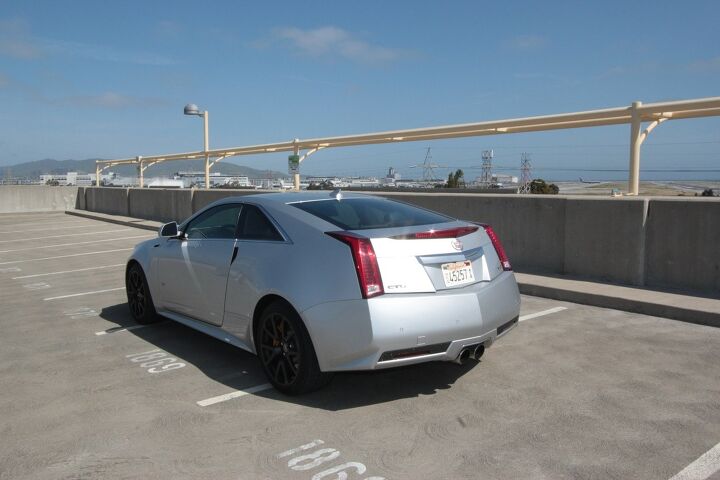






















































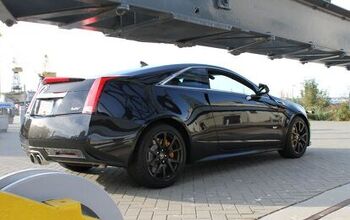
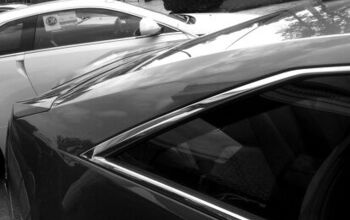

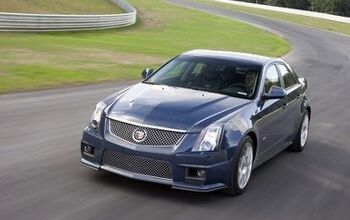
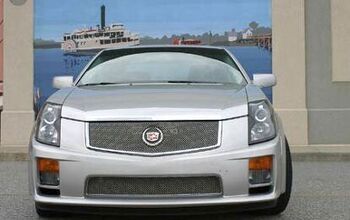










Comments
Join the conversation
I was not impressed with the test drive of the CTS V. It had a terrible ride for a luxury car. Fine for a sports car but very much rode like the Corvette. So why buy this over a Corvette that is quicker and costs $20K less? If it is for the back seats, that is not saying much, as bigtruckseries pointed out. I think his choice of an SRT8 is far more educated (I gladly would give up a half second to sixty for the better ride and more space). It definately is not for the CTS V's extra comfort. Its seats are worse than the Corvettes, IMO (the Recaros fix that for a big adder). It bucks when you let off the accelerator and has nowhere near the options provided by its German counterparts. And because of its excessive weight for such a small vehicle, it is no wonder it rides like a Corvette. And lastly, its reliability is only mediocre which is why most people abandoned Cadillac in the first place. If I were to buy a CTS, it would be the standard CTS suspension with an LS3 for power. That would be my idea of a cost effective luxury car with plenty of power for $50K.
"I would be remiss in noting that while the M3 loses a bit of headroom in coupe form, it’s a far more livable backseat, if you’re into that sort of thing." You just noted it, therefore you are remiss. Shame on you. (Were you trying to be remiss? http://dictionary.reference.com/browse/remiss) "The electronic nanny reigns in the fun at more-or-less the right moments..." Funny, I wouldn't have expected an electronic nanny to be the Queen of Fun. (http://dictionary.reference.com/browse/reign) Otherwise, pretty good review.